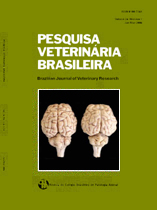 |
|
|
|
Year 2011 - Volume 31, Number 11
|

|
Clinical signs, lesions and productive and reproductive changes in goats poisoned by Ipomoea carnea subsp. fistulosa (Convolvulaceae) that discontinued to ingest the plant, 31(11):953-960
|
ABSTRACT.- Oliveira C.A., Riet-Correa F., Dutra M.D., Cerqueira D.V., Araújo C.V. & Riet-Correa G. 2011. [Clinical signs, lesions and productive and reproductive changes in goats poisoned by Ipomoea carnea subsp. fistulosa (Convolvulaceae) that discontinued to ingest the plant.] Sinais clínicos, lesões e alterações produtivas e reprodutivas em caprinos intoxicados por Ipomoea carnea subsp. fistulosa (Convolvulaceae) que deixaram de ingerir a planta. Pesquisa Veterinária Brasileira 31(11):953-960. Programa de Pós-Graduação em Saúde Animal na Amazônia, Campus de Castanhal, Universidade Federal do Pará, Rua Maximino Porpino da Silva 1000, Pirapora, Castanhal, PA 68743080, Brazil. E-mail: griet@ufpa.br
The aim of this research was to study the clinical signs, productive and reproductive performance, and lesions of goats poisoned by Ipomoea carnea subsp. fistulosa after removal from the paddocks where the plant occurred. Thirty seven goats were divided into four groups: Group 1 consisted of 14 goats with poor body conditions and mild to severe nervous signs, acquired from a farm where the plant occurred; Group 2 (control) consisted of 10 goats which had also poor body conditions, but were acquired from a farm where the plant did not occur; Group 3 consisted of two goats with clinical signs of intoxication and which were slaughtered on the farm where they became poisoned; Group 4 consisted of 11 goats slaughtered as controls for the study of gross and histological lesions. The animals from Group 1 and 2 were evaluated for a period of 12 months on a farm located in the municipality of Castanhal/Pará, in a paddock where the plant did not occur. Six months later, the animals of Group 1 continued with poor body condition, rough hair coat, and nervous signs, especially intention tremors, what became with time less noticeable. In the same period, the goats of Group 2 gained an average of 13 kg body weight. Goats from Group 1 showed to be more susceptible to gastrointestinal parasites than those from Group 2. From the eight goats of Group 1 remaining on the farm only 4 became pregnant and delivered three kids which died shortly after birth, while all goats from Group 2 got pregnant and delivered healthy kids. At necropsy, two goats from Group 1 showed cerebellar atrophy. The main histological change observed in animals of Groups 1 and 3 was a decreased number of Purkinje cells in the cerebellum. It is concluded that goats chronically intoxicated by I. carnea and which discontinued to ingest the plant but showed still clinical signs, even though diminished in intensity, had poor productive and reproductive performance and were highly susceptible to gastrointestinal parasites. For economical reasons, it is suggested that farmers cull affected animals which show still nervous signs 15 days after the end of I. carnea consumption. The most common permanent clinical signs are intention tremors, probably due to the loss of Purkinje cells, what could be primarily responsible for the malnutrition of the goats, the resulting reproductive failure and increased susceptibility to gastrointestinal parasites. |
| |
|
|
| |
|
 |